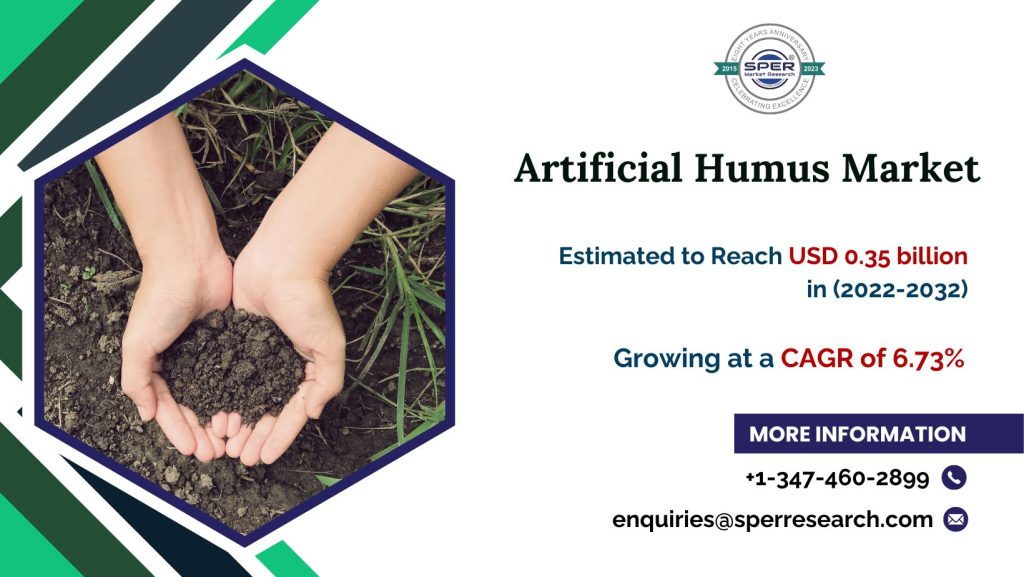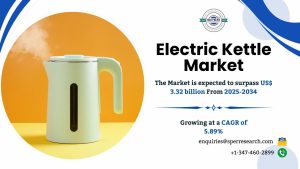A material called humus is derived from dead leaves and plants and is applied to the soil to promote plant growth. Partially decomposed organic substance is called humus. Producing crops with high yields requires the use of artificial humus. Many beneficial minerals for good soil are present in humus. Nitrogen is one among the most significant. Humus contains nutrients, including nitrogen, that are essential to agriculture. Humus gives the soil its capacity to take in and retain moisture. These kinds of soils need far less irrigation since they never dry out. Furthermore, humus feeds well-known microbes such the phosphate solubilizing bacteria and rhizobacteria, which are essential for all legume nodulation.
According to SPER market research, ‘Artificial Humus Market Size- By Form, By Application- Regional Outlook, Competitive Strategies and Segment Forecast to 2032’ state that the Global Artificial Humus Market is predicted to reach USD 0.35 billion by 2032 with a CAGR of 6.73%.
The key element motivating the usage of artificial humus is the declining soil quality. The foundation of life and guardians of the climate is soil. Furthermore, the global market for artificial humus is expected to rise as a result of the growing need for organic fertilisers and bio stimulants. The market is expanding primarily due to the rising demand for organic fertilisers and the rising rates of soil deterioration. Humus has numerous benefits, including increased soil fertility, improved soil digestion, increased microbial activity, and increased soil organic matter content. Moreover, it increases buffering capacity, suppresses weed development, and provides high humus levels. The market for artificial humus has expanded significantly as a result of these benefits.
Farmers’ poor awareness of the usage of artificial humus is pounding away at the growth of markets. Farmers use synthetic fertilisers and other items because they are unaware of the benefits that artificial humus provides. One of the most prevalent strategies for progressively increasing soil organic matter and promoting soil biology is the use of compost or humic compounds. Because they are no longer as reliable, just a small portion of farmers utilise them. Furthermore, compost may contaminate the soil with new pathogen-like organisms, pests, diseases, and undigested seeds. Undigested weed seeds and potentially harmful microorganisms may be present in manures that have been added. Farmers are compelled to apply pesticides as a result, which damages the ecology. Because of this, the development of synthetic humus market is hampered.
Request For Free Sample Report @ https://www.sperresearch.com/report-store/artificial-humus-market.aspx?sample=1
Product consumption has decreased as a result of the COVID-19 infestation, which is explained by government efforts to maintain social isolation, confinement, and store occupancy levels. An enormous global death toll from the COVID-19 pandemic has exacerbated an already dire economic catastrophe. As a result of inconsistent supply chain operations and a market that was subject to lockdowns and trade restrictions, businesses had challenges during the COVID-19 pandemic. The food and jewellery production chains have seen significant modifications.
Artificial Humus Market Key Players:
Geographically, in terms of revenue, Asia-Pacific accounted for the greatest portion of the worldwide artificial humus market, accounting for over one-third of the total. It is anticipated that this region would continue to dominate the market in the years to come. Additionally, some of the key market players are Agbest Technology Co. Ltd, ARCTECH Inc, Cifo SRL, Faust Bio- Agricultural Services, Humintech, and others.
Global Artificial Humus Market Segmentation:
By Form: Based on the Form, Global Artificial Humus Market is segmented as; Granules, Liquid, Powder.
By Application: Based on the Application, Global Artificial Humus Market is segmented as; Agriculture, Horticulture, Ornamental and flowers, Seed treatment, Others
By Region: The regions of Europe, Asia-Pacific, North America, South America, the Middle East, and Africa make up the majority of the world’s humic acid market. Europe held the highest previous year; which is expected to diverse. The largest economy in Europe is found in Germany, where agricultural occupies roughly half of the country’s territory. It is the third-largest exporter of agricultural products worldwide. The primary crop in around one-third of Germany’s farmland is grain, which is then followed by barley and rye. Additionally, animal feeds are essential in the process of producing food. Manufacturers of animal feeds in Germany include, Deutsche Tiernahrung Cremer GmbH & Co. KG, Worlée, and Kiwa. Over the course of the analysis period, more manufacturers of animal feeds are anticipated to increase the demand for humic acid.
This study also encompasses various drivers and restraining factors of this market for the forecast period. Various growth opportunities are also discussed in the report.
For More Information, refer to below link:-
Artificial Humus Market Outlook
Related Reports:
Follow Us –
LinkedIn | Instagram | Facebook | Twitter
Contact Us:
Sara Lopes, Business Consultant – U.S.A.
SPER Market Research
+1-347-460-2899



